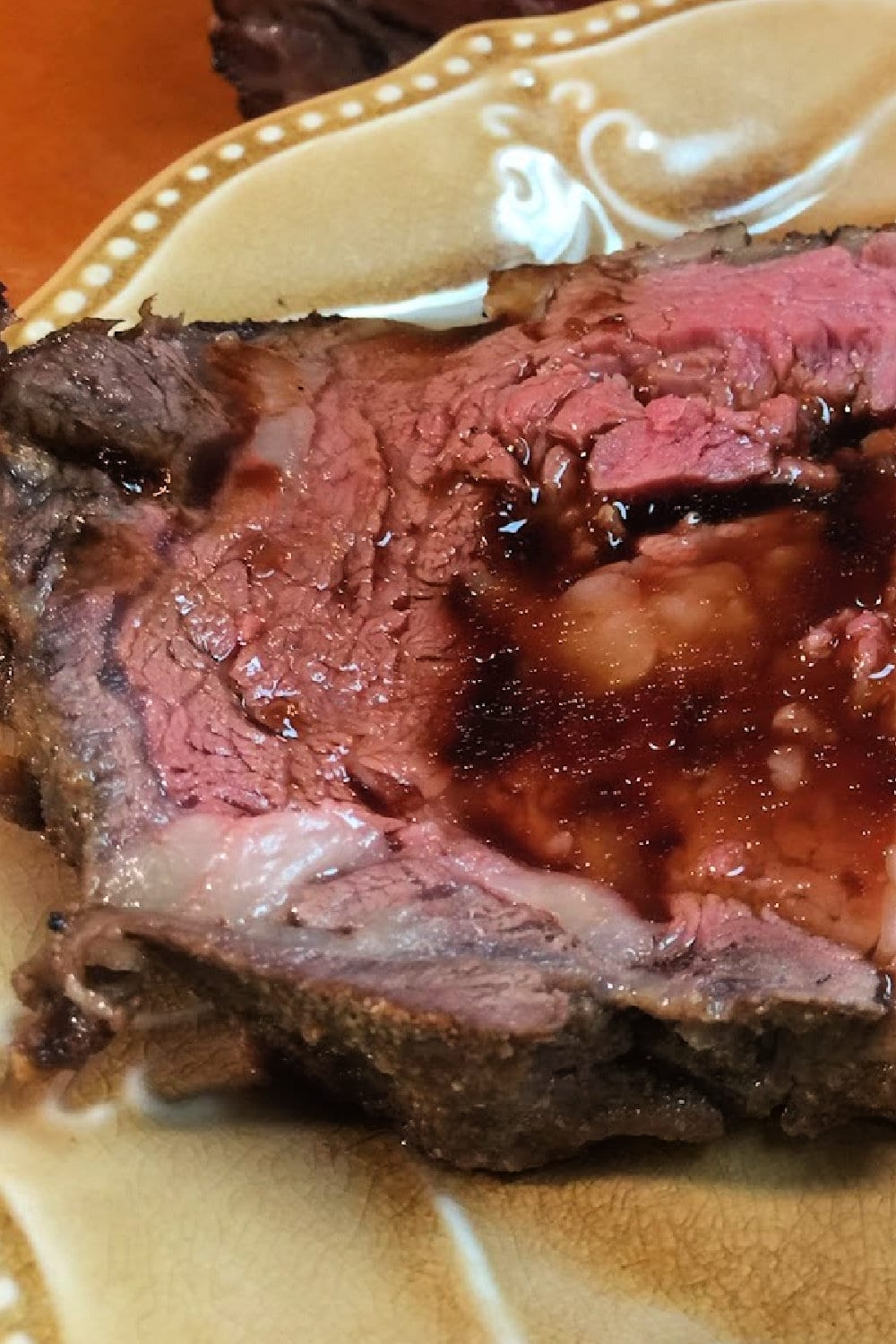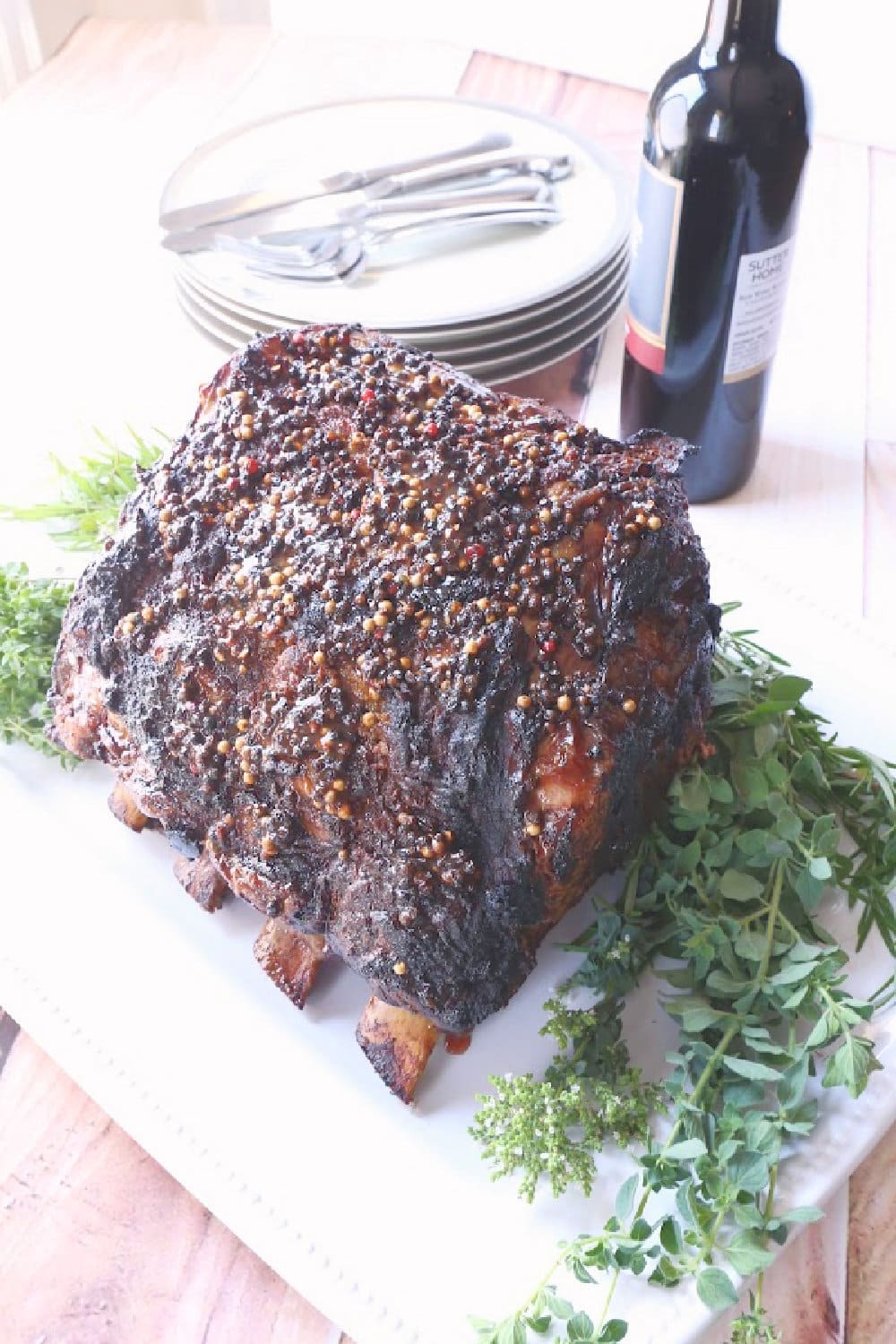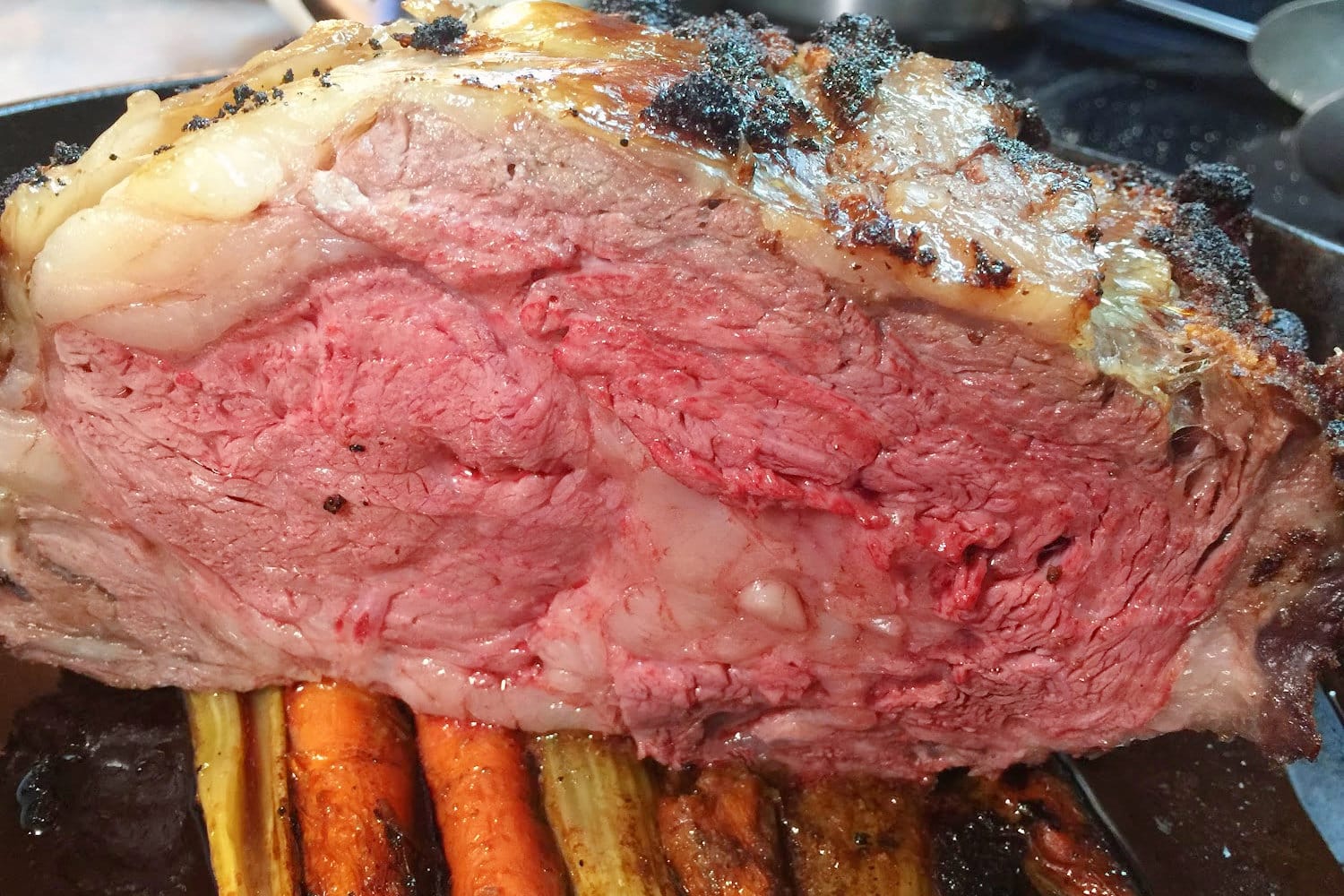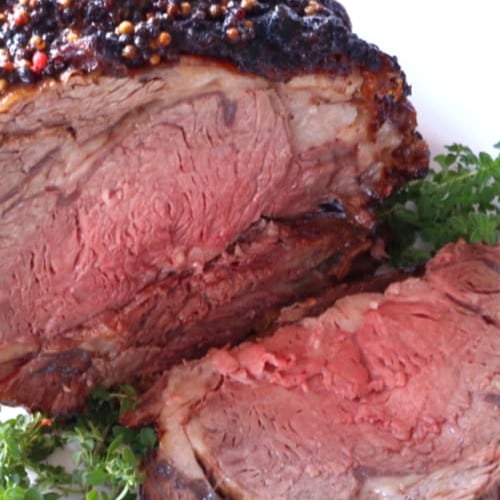Making tender and juicy perfect prime rib roast in the oven is easy and doable using the 500 rule. How to Cook Perfect Fool-Proof Prime Rib is the best, most detailed recipe you’ll find.
Just follow my step-by-step directions below….you do not need to be afraid! You can conquer and I’m here to show you how.
We love making prime rib roast in the oven for Sunday gatherings and Christmas, New Year’s Day, and Easter holiday dinners.

Prime Rib Roast Recipe
If the words PRIME RIB AT HOME put FEAR in your heart, you’ve come to the right place. I am here to tell you that you can conquer it!
I remember the first time I used this method to cook a prime rib, I was really apprehensive about it.
A prime rib is an expensive hunk of meat. I was worried that I’d ruin the dang thing, wasting my hard-earned money AND my precious time.
Finally, I took the plunge and tried this recipe, following the instructions to the letter. It works perfectly! I’ve never looked back.
Why is This No-Peek 500 Degree Rule the Best Prime Recipe in the World?
Whenever you’re in a position to feed a group of people this prime rib recipe will become your go-to method.
It makes perfect prime rib roast in the oven and creates a holiday tradition that makes special memories for our family and guests.
So This No-Peek 500 Degree Rule for Cooking Prime Rib Really Works?
Yep, it sure does! I know it sounds weird, but it really works like a charm.
When you’re cooking prime rib roast in the oven, this method is ultra-easy and pretty much foolproof. It allows for roasting and resting of the beef at the same time within this one cooking method.
Roasting and resting are both very important steps for producing medium-rare, tender and juicy, perfectly-cooked slabs of prime rib.
Why Cook Prime Rib Roast in the Oven?
Well, because who wants to stand around grilling steaks when you’ve got special guests to tend to?
Prime rib roast in the oven is special and delicious, and also great to cook in the oven. Prime rib is a huge RIB-EYE roast, the same cut that rib-eye steaks are cut from, and it’s magnificent.

What To Consider When Cooking a Prime Rib Roast
There are a few things to consider when purchasing your rib roast to make prime:
- what rib roast to purchase
- how much roast to purchase
- how you’ll be cooking
- how to slice and serve
- what side dishes you’ll need
Best Prime Rib Rub
Seasoned Salt, Granulated Garlic, Granulated Onion, and Freshly Ground Black Pepper make the crust of your standing rib roast. You’ll season the exterior of your standing prime rib roast with and use it for your prime rib rub. This makes the exterior nice and flavorful as you roast it in the oven, then enjoy it for dinner.
The Best Creamy Horseradish Sauce
Prime rib just isn’t prime rib if there’s no horseradish sauce to accompany it. The main ingredient in horseradish sauce is sour cream, but the most important ingredient is the horseradish, hands down.
You’ll need what’s called prepared horseradish, which is freshly grated horseradish root. Don’t make the mistake of getting cream-style horseradish that’s located in the condiment aisle of the grocery store.
The remaining ingredients needed for making horseradish sauce are things you’ll likely already have on hand including:
- whipping cream
- spicy brown mustard
- Worcestershire sauce
- white wine vinegar
- crushed garlic
- salt
- pepper
You can make the horseradish sauce ahead of time and store it in the fridge until ready to serve.
Au Jus Sauce for Ribeye Roast
Au jus (pronounced ah-zhoo) refers to thickened juices from a roast or other meat. The term translates literally to “with the juice.”
Traditional prime roast has always been served with an au jus. Typically it is drizzled over an individual slab of prime rib, accompanied by a dollop of horseradish sauce.
Many people use a basic simmering beef broth as their au jus to keep it simple.
Common Questions When Making Standing Rib Roast
Should I seek out a butcher shop when I want to purchase my standing rib roast to make prime rib? And what questions should I ask the butcher?
Use the best grade of rib eye roast! A good butcher shop will be knowledgeable. They will answer any questions you may have about pricing, how much you need per person, cooking, etc.
A good butcher really wants you to be successful cooking and wants you to return as a customer.
Also, tell your butcher the full story so he gets the big picture. Let them know what you’re trying to accomplish. Share how many people you’re serving, and that you’re nervous about the whole prime-rib process if that’s the case.
A butcher can’t help if they don’t have all the details! Butchers are very accustomed to their customers feeling apprehensive when purchasing and cooking their first standing rib roast.
Is it okay to purchase the prime rib that is available from the meat case at my local grocery store?
The primary difference in a PRIME prime rib (what you would typically purchase from a good butcher shop) and a CHOICE prime rib (what you’ll typically find at your local grocer) is basically this: the amount of marbling within the roast.
Why does this amount of marbling matter? Marbling really contributes to the level of flavor and juicyness in the eating experience of the prime rib.
Prime rib is a very fatty cut of beef. Many people feel that cooking a CHOICE prime rib is still delicious!
I have always purchased prime rib from a butcher since I typically only cook it ONCE a year. I want it to provide the best eating experience available to me and my family. I want that rich, buttery flavor and texture plus lots of juicy-ness, too.
If I purchase a CHOICE prime rib roast instead of a PRIME prime rib roast, do I need to cook it differently?
If you purchase choice prime rib from the grocery store, it will most likely be boneless.
If you’re cooking a choice prime rib that’s boneless, it will cook much more quickly than a bone-in prime rib. The choice cut of prime rib has less marbling. This will contribute to how quickly the roast cooks.
When cooking choice prime rib, opt to undercook it since there is less of the marbling in the meat. You can always cook a prime rib more (longer) but once it’s overcooked, you cant’ go back!
Why are there so many names for prime rib? It’s pretty confusing.
It can be very confusing when purchasing a prime rib roast for the first time. There are many different names for the same cut of beef including:
- rib roast
- rib eye roast
- standing rib roast
- eye of rib roast
- prime rib roast
Your butcher can help you understand the names, but just know they are all one and the same roast.
Choice prime rib from a grocery store has prominent prime rib labeling to help customers easily identify the cut.
Is it true that prime rib is best when served medium rare?
Most folks feel that prime rib is should be served medium rare for the best dining experience.
After roasting the rib eye roast, let it continue to rest for exactly two hours inside the closed oven. You will have the most succulent, juicy, amazing prime rib…..perfectly medium-rare and perfectly cooked, all ready to serve and enjoy!
What is the ideal internal temperature for a prime rib that is considered medium-rare?
The internal temperature for a medium-rare prime rib is 130-135 degrees F. at the center of the roast. You will need an instant-read meat thermometer to determine the internal temperature of the prime rib.
How should I insert an instant-read meat thermometer into the prime rib to take the correct internal temperature?
Insert the thermometer into the center of the roast. Go straight in from the side where the meat is the thickest. Coming in from the side helps ensure you don’t touch any bones or the bottom of the roasting pan. This can give a false temperature reading.
Watch the dial once you insert the instant-read meat thermometer into the prime rib. Once the temperature stops rising that is the internal temperature of the roast. This will just take 30-60 seconds.
For a perfect prime rib that’s medium rare, the internal temperature should be 130-135 degrees F. Some people say 135-140 degrees F. is better, but it’s a toss up.

How MUCH prime rib should I purchase for my gathering?
Most butchers recommend purchasing one pound of boneless rib eye roast for each person at the meal.
Prime rib roasts are sold two ways: bone-in or boneless. Boneless rib eye roasts are typically cheaper and easier to manage your first time. A bone-in rib eye roast provides more flavor and a juicer, richer eating experience.
Each rib of a bone-in rib eye roast has up to 2 lbs. of meat. Therefore, if you serve prime rib to a group of 8 people, you’d need a 4-rib roast.
For a bone-in rib eye roast for prime rib never buy a roast with less than 3 ribs.
Wait. So when I’m purchasing a bone-in prime rib, I’m supposed to ask the butcher to cut off the bones? How come?
Yes! I know it may sound weird, but hear me out. Cooking with the bones is going to give it a lot of additional flavor due to the bone marrow.
Once cut from the prime rib roast, the butcher can tie the bones back onto the roast.
When the prime rib roast is cooked and ready to slice, snip the strings. Lift the roast right off the rack of bones and onto your cutting board. You can now very easily slice that prime rib roast.

How long should I cook my prime rib using the 500 degree rule?
Here’s the formula for cooking medium-rare prime rib:
Take the weight of your prime rib roast and multiply it x 6 minutes. For example, a 6 lb. rib eye roast multiplied x 6 minutes = 36 minutes in the oven at 500 degrees F.
Here’s the formula for cooking medium prime rib:
Take the weight of your prime rib and multiply it x 7 minutes. As an example, a 6 lb. roast multiplied x 7 minutes = 42 minutes in the oven at 500 degrees F.
Please Note: I don’t typically recommend that prime rib should be cooked to medium as an internal temperature. Once you’ve over-cooked a piece of meat, there’s no going back.
If you’ve cooked a piece of meat to a more rare state, you can always cook it longer to raise the internal temperature to what you prefer.
Is there a special technique for cooking a prime with a crust and nicely charred exterior?
Uncover your rib eye roast the night before and let it sit naked in the fridge. This will really help with that beautiful browning we long for.
Why is it important to know exactly how much your prime rib weighs when you are ready to cook it?
The KEY to making sure this no-peek closed-oven-door method works is to know the weight of your roast. Then you can cook it according to the formula above.
When you open up that parcel of prime rib, be sure you keep the label that has the weight!
Stick the label somewhere safe because. You will need it when you get ready to prepare your prime rib. See above for the exact cooking formula needed.
Medium Well Done or Well Done Prime Rib Tips
You may have THAT ONE GUEST who will insist that “they only eat their prime rib WELL DONE.” Ewwww….but whatever, right??
If you have guests who think that medium-rare prime rib slice isn’t cooked enough, here’s a hack. Keep a skillet of simmering beef broth on your stove top!
Simply slide their slice of prime rib slice into the simmering broth and let it cook for a few seconds. The prime rib slice will cook very quickly and you can then remove it from the broth to their plate. It will be moist and delicious. Just what they want….and everybody’s happy!!

Do I need fancy tools to cook prime rib successfully?
The tools needed to make prime rib roast in the oven are minimal, truly. You’ll need a large roasting pan, a roasting rack, a sign for your oven door, and some duct tape.
It’s a good idea to have a couple of instant-read meat thermometers on hand, for checking the internal temperature. (I like having two on hand so that I’ve got a second one as a back-up for temping my roast.)
Don’t forget to have a large cutting board with a channel around the edge, heavy-duty meat or grilling forks for lifting the prime rib from the rack of bones to the cutting board, a sharp carving knife, and a platter for serving.
The 500 Degree Rule Means NO PEEKING
Once the prime rib roast is finished roasting at 500 degrees F., DO NOT OPEN THE OVEN DOOR. Even though you’ll be dying to see what your prime rib looks like at this point.
Turn your oven to its lowest temperature setting (usually 170 degrees F. for most ovens. Then set your timer FOR TWO HOURS following the initial roasting process at 500 degrees F. This is where the duct tape and signage are essential. You don’t want anybody opening the door, including yourself.
DO NOT open that oven door for ANY reason!
When making prime rib for the first time, is it okay if I go ahead and purchase a boneless rib roast instead of one that has the bones attached to the roast as you recommend above?
I know lots of people who have done this when starting out with making prime rib.
This may make the entire process less intimidating.
No matter what we are cooking, its very important to feel successful so that we want to continue. If you feel that your first prime rib should be boneless, that is totally fine!
Is it true that you shouldn’t cook prime rib while it’s still cold from being in refrigeration? Why?
YES! This is called BEAUTY REST for your beef, and it is so very essential. Cooking any meat without letting it rest at room temperature is suicidal, in my humble opinion.
When a hunk of meat has been in refrigeration, all the juices and fats are coagulated at the very center.
Resting at room temperature allows juices and fats to move from the center to the outer areas of the roast.
During this, the roast and all of its protein fibers can relax in preparation for the cooking process.
Adequate rest ensures that your prime rib roast can cook much more evenly and consistently. This provides a far better eating experience later. Just what we long for!!
Don’t be afraid to remove your prime rib roast from refrigeration at least 4-5 hours before the cooking process.
And does the prime rib need beauty rest AFTER it’s finished cooking as well?
YES!!! And this recipe makes it super easy – you won’t even have a chance to do otherwise!
Do I have to serve the prime rib with the au jus or can I skip that?
You can skip the au jus, if preferred. If your prime rib is served medium-rare, it will be super-juicy and tender. Nobody will miss au jus too much.
And yes, many people substitute plain beef broth instead of homemade au jus – it’s acceptable.
Keep a simmering pan of broth or au just on the stove. This will give you the option of cooking a slice of prime for somebody who wants it done more. There’s always THAT ONE, as we discussed above.
But please don’t ever skip the creamy horseradish sauce – this is just essential to prime rib!
When cooking prime rib to serve several people, is it better to cook one large prime rib roast or two smaller rib roasts instead?
I’m so glad you asked – this is a great question! Let’s say you’re feeding 10 people. Instead of getting one large 5-bone prime rib roast, opt for two 3-bone rib roasts, instead.
When using this specific cooking method (the closed-oven method), I’ve found that two smaller rib roasts work best.
The 500 degree method doesn’t work well with prime rib roasts smaller than 2 ribs. They easily overcook.
What is the best way to slice and serve my prime rib roast?
If you have a standing rib roast that’s had the bones removed and then tied back on, cut the strings while it’s still in the roasting pan.
Lift the roast up and off the bone rack that it’s resting on. Place the prime rib onto a large cutting board where you have ample room for slicing.
Cut the prime rib into thick slices and place it onto dinner plates.
Pour a bit of the warm au jus over each slice and add a dollop of the creamy horseradish on the side. Ta-dah!!!
What are good side dishes to serve alongside prime rib at my dinner?
Everybody has a preference for their favorite side dishes for prime rib roast in the oven. Here are a few of my family’s favorite side dishes:
- Creamy Mashed Potatoes Supreme with French Fried Onions and Bacon
- Sweet Potato Crumble or Sweet Potato Balls with Crispy Cornflakes
- Cheesy Pull-Apart Pesto Bread
- Saucy Beans with Beef and Bacon
- Delta Cornbread Salad

How to Cook Perfect Fool-Proof Prime Rib in the Oven
Ingredients
For the Prime Rib
- 8-10 lb. bone-in 4-rib standing rib roast, bones cut off and tied back on by the butcher, room temperature
- 1 Tbs. granulated garlic
- 1 Tbs. granulated onion
- 1 Tbs. freshly ground black pepper may add some peppercorns
- 1 Tbs. seasoned salt
For the Creamy Horseradish Sauce
- 1 cup sour cream
- 1/2 cup whipping cream or heavy cream
- 1-2 dashes hot pepper sauce, as desired
- 1 Tbs. Worcestershire sauce
- 2-3 Tbs. prepared horseradish **Note: this is the refrigerated fresh-grated horseradish, not the creamy-style found in the condiment section of the grocer
- 1 Tbs. spicy brown mustard
- 1 Tbs. white wine vinegar
- 2 cloves garlic, crushed
For the Au Jus
- 3 cups water
- 5 tsp. Better Than Bouillon Concentrate, Beef Flavor (or use beef bouillon cubes)
- 1 Tbs. soy sauce
- kosher salt and freshly ground black pepper, to taste
Instructions
Prime Rib
- 4-5 hours prior to cooking the prime rib roast, remove it from refrigeration; unwrap the roast from all packaging. Combine the granulated garlic, granulated onion, and black pepper with the seasoned salt in a small bowl. Using your fingertips, rub spice blend over every area of the roast.
- When you are ready to cook the prime rib roast, pre-heat the oven to 500 degrees F., placing your oven rack in the lower third of the oven.
- Place the seasoned roast, fat side up, onto a roasting rack in your roasting pan. If you don't own a roasting pan, you can also use a very large cast iron skillet, depending on the size of your roast. Or, you can even turn a rimmed baking sheet into a roasting pan, if needed.
- Place the prepared rib roast into the preheated 500 degree F. oven, uncovered, and cook for 6 minutes per pound for medium rare. (As an example, a prime rib roast that weighs 10 lbs. would cook for 60 minutes at 500 degrees F.)
- When the timer sounds, immediately turn your oven temperature down to the lowest setting, which for most ovens is 170 degrees F. NO MATTER WHAT, DO NOT OPEN THE OVEN DOOR! Set your timer for 2 hours at this point. Now is the time to break out your duct tape and signage to lock down your oven door. Tape it shut with as much duct tape as needed, adding the DO NOT OPEN sign as well. Do WHATEVER IS NEEDED to make certain that oven doors stays absolutely shut for the next two hours!!
- When the timer sounds at the full 2 hour mark, open the oven door, using an instant-read meat thermometer to check the internal temperature of the meat. For medium rare prime rib, you'll want the internal temperature to be 130-135°F.
- If your roast temps a bit cooler than 130-135 °F, simply preheat your oven to 375 °F., returning the roast to the oven until the internal temp reaches 130-135 °F, checking the internal temperature every 10 minutes or so until the prime rib raises a few more degrees to the desired temperature.
- Snip the strings that are holding the bone rack to the prime rib roast. Using big forks, lift the prime rib roast from the rib rack and the roasting pan, placing it onto a large cutting board.
- Slice the prime rib into thick slices, placing them onto dinner plates. Pour a bit of the warm au jus over the prime rib, then add a dollop of horseradish sauce alongside. Serve at once.
Creamy Horseradish Sauce
- Combine all the sauce ingredients in a small bowl until smooth; store in the fridge until ready to serve.
Au Jus
- Place the water into a skillet and bring to a boil; reduce the heat to low, then add the bouillon concentrate, as well as the soy sauce, and garlic, whisking until well blended. Season to taste with salt and pepper; keep warm.
Notes
Nutrition
More Delicious Meat Recipes to Enjoy –
- How to Make Tender and Juicy Smoked Beef Tri-Tip….That Slices into Slabs of Steak!
- Instant Pot Beef Barbacoa with Fresh Corn Salsa
- Maple Pecan Glazed Ham
- Country-Fried Steak Fingers with Cream Gravy
- Instant Pot Hot Beef Sandwiches with Brown Gravy….Just Like Grandma Made
- Instant Pot Easy Swiss Steak
- How to Cook Eye of Round Roast Beef
The post How to Cook Perfect Fool-Proof Prime Rib appeared first on Chef Alli.

